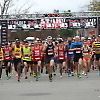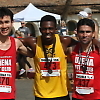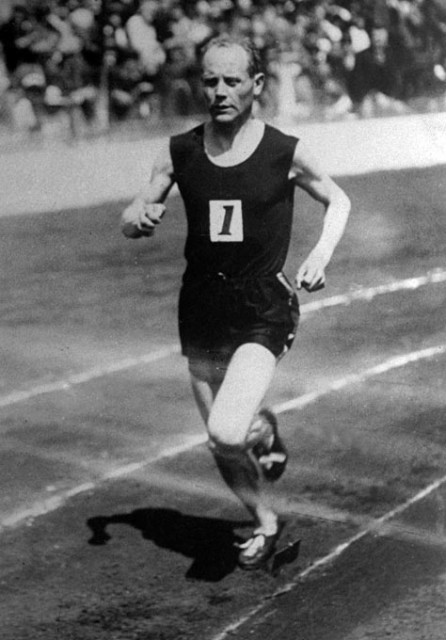UjENA FIT Club 100 Interesting Running Articles
Best Road Races and the UjENA FIT Club is publishing 100 articles about races, training, diet, shoes and coaching. If you would like to contribute to this feature, send an email to Bob Anderson at bob@ujena.com . We are looking for cutting edge material.
Click here to read all Running Articles
Posted Wednesday, February 11th, 2015
By David Prokop Pleasanton, Calif., may be a quiet, relaxed community across the bay from San Francisco, but where Double... Read Article
Posted Monday, September 15th, 2014
Peter Mullin has taken Double Racing® by storm. He broke the 60-64 age group world record in the first Double... Read Article
Posted Monday, September 22nd, 2014
by David Prokop (Editor Best Road Races) Photo: Double 15k top three Double Racing® is a new sport for... Read Article
Posted Sunday, May 11th, 2014
By David Prokop, editor Best Road Races The world’s most unusual race met the world’s most beautiful place, in the... Read Article
Paavo Nurmi
Friday, July 13th, 2012
Six Days In July 1924
by Barry Anderson The recent article by George Hirsch on Emil Zatopek and his triple gold medal performance at the 1952 Olympic Games in Helsinki provided some wonderful insight into this great distance runner. To be able to witness such excellence in person obviously has etched a forever lasting memory for George Hirsch of Zatopek as a person and a runner. In keeping with the Olympic theme, we will be presenting some additional articles on distance running greats and their accomplishments in Olympic competition. Prior to Zatopek’s trifecta in 1952, he began his road to Olympic greatness with two outstanding performances in the London games in 1948. His winning of the 10,000 and silver medal in the 5,000 both foreshadowed his record breaking performances to come in 1952 and, signaled the end of more than three decades of distance running dominance by a single country that has never to date been matched. In the six Olympic games held from 1912—when the 10,000 and 5,000 were added—through 1936, one relatively small European country won nearly half (48.1%) of the medals available in these two distance track events and the marathon. Finland was so dominating during this time frame that even with the emergence of the African nations beginning in Rome in 1960 the Finnish still today have won more Olympic medals in these three events than any other nation.
Unlike Zatopek, the lone Czechoslovakian medalist ever in these three distance events, the Finnish team was deep in numbers and quality. Hannes Kolehmainen led off the domination with gold medals in both the 5k and 10k and an individual win in the 3000 meter team race in the 1912 Stockholm Olympics. He would follow this performance up with a marathon victory 8 years later at the next Olympic games, held in 1920 due to the war. Also at these Antwerp Olympics in 1920 a string of individual distance performances over a span of three Olympics was started by the finest Finnish runner of all during the 1920’s and likely forever, Paavo Nurmi. Many who follow Olympic track, and distance events in particular, would consider Nurmi to be the greatest Olympic champion of all time. The 5’ 9”, 145 Nurmi was basically self-coached and is said to be one of the first runners to train—and often race—with a stopwatch. Running historians also believe Nurmi to be one of the first to have carefully planned workouts that, interestingly, included a great deal of walking. He was also a pioneer in pacing races. The majority of distance races at this time were run very conservatively with runners saving their efforts for the final lap of the race. Nurmi would often take the lead early in races at a pace he knew he could maintain based on his timed pace runs in workouts. In his three Olympic appearances, Nurmi won nine gold medals and three silver medals. It should be noted that there were additional medal opportunities and events held in 1920 and 1924. Cross-County, an approximately 10,0000 meter race with both Individual and Team medals was held in both years. A 3000 meter team race was also included in the 1924 Paris games. (Note: The medal counts used for country comparisons earlier in this article do not include these additional events.) After winning the 10,000, finishing second in the 5000 (In his only Olympic loss to a non Finnish runner), and winning the Individual and Team Cross-County race in the 1920 Antwerp Games to earn 3 gold medals and a silver, the greatest six days of Olympic distance running were yet to come for Nurmi—4 years later in Paris. As a part of his preparation for the Paris Games, Nurmi added more speed training to his workout program of slower, longer runs. By the end of 1923 Nurmi held the world record in the mile, 5000, and 10,000—an accomplishment that no other runner has ever achieved. In fact, during his long career, Nurmi set 25 world records from the 1500 to the 20k. Needless to say, when Nurmi arrived in Paris in July of 1924 great deeds were expected. Comments and Feedback
 Paavo Nurmi was such an amazing distance runner...really enjoy your article Barry... Paavo Nurmi was such an amazing distance runner...really enjoy your article Barry...Bob Anderson 7/13/12 4:08 pm |
,,,,, |
The timeline of Nurmi’s seven races with seven victories, five Olympic gold medals, and two Olympic records went as follows: July 8, 1924: Semi finals of the 5000. Nurmi easily wins his heat in 15:28.6 to qualify for the finals. July 9, 1924: Semi finals of the 1500. Nurmi again easily qualifies for the 1500 final with a win in his heat at 4:07.6. July 10, 1924: Nurmi’s first race of two on this day is the finals of the 1500. He is pushed to a new Olympic record of 3:53.6 by runners from Sweden and Great Britain and narrowly misses his existing world record of 3:52.6. The second race on this day for Nurmi is the 5000 final. There is quite a range of the reported time span between the finish of the 1500 and start of the 5000 from a low of 25 minutes to nearly two hours. Multiple accounts set the time at about 40 minutes of rest between the races. Nurmi wins his second Olympic gold medal of the day, beating his Finnish rival Ritola by two tenths of a second in another Olympic record time of 14:31.2. July 11, 1924: Semi finals of the 3000 team race. Nurmi wins his heat in 8:47.8 and the Finnish team easily qualifies for the finals with a sweep of the top three places. July 12, 1924: Cross-Country Individual and Team final. This was perhaps the most difficult physical challenge that Nurmi faced during the six days of racing. Due to the difficulty of the course with its hills and deep weed cover, and the intense heat, only 15 of the 38 runners who started the 10k (actually 10,650 meters) race were able to finish. Nurmi easily won the individual title by nearly a minute and a half over Ritola for his third Olympic gold of the week. The Finnish team won over the second place USA team for Nurmi’s fourth gold medal. July 13, 1924: 3000 team race final. Nurmi wins his seventh race in six days with an individual victory again over his teammate Ritola in a time of 8:32. Finland also picks up a fifth place finish in the race to win the team gold medal for Nurmi’s record setting fifth gold of the 1924 Olympic games.
Led by Nurmi and his incredible 6 days of racing, Finland totally dominated the distance events in steamy Paris. The Finnish runners won every distance event from the 1500 up for a total of 8 gold medals and showed their depth with three silvers, a bronze, and 5 other top 5 finishes. Nurmi continued his Olympic performances in the 1928 Amsterdam Olympic games at the age of 31. There he won the 10,000 in an Olympic record of 30:18.8, placed second to Ritola in the 5000, and ended his Olympic career with a second place in the 3000m steeplechase behind a world record performance by another Finnish teammate. Most of the sources reviewed site this final as only the second steeplechase Nurmi had ever run—with the first being the preliminaries three days earlier. This would be Nurmi’s last Olympic games. Speculation about his amateur status led the International Amateur Athletic Association to suspend Nurmi from international competition—including the 1932 Games in Los Angeles. Though he was unable to run, Finland continued its Olympic distance running domination in 1932 and Berlin in 1936 by winning 10 of the 18 medals presented in the three distance events. Nurmi continued to run competitively in his home country through 1934. Even with the greats of recent times like another Finnish Olympic star in Lasse Viren or even more recently Kenenisa Bekele of Ethiopia there likely will never be a more decorated Olympic champion in the distance events than Paavo Nurmi. And, with the changes in event schedules over the years to avoid same-day distance finals and add rest days between the finals and qualifying rounds, there will never be another distance runner accomplish so much in six days straight of Olympic competition. Six days, seven races, five Olympic gold medals—kind of says it all for this greatest of all Olympic distance champions, Paavo Nurmi.
|

Copyright 2025 UjENA Swimwear · Site Map · Feedback · Tell A Friend · Nominate a Race
Leaderboard · UjENA 5K · Double Road Race · UjENA Jam · UjENA Network














[1].jpg) Finland’s total of 31 medals—including 16 gold medals—ranks above the 24 won by Ethiopia and the 19 won by Kenya. Great Britain, Germany, and the United States are the only other countries in double digit medal wins with 12, 11, and 10 medals respectively. When you consider that Finland won 12 GOLD medals during this 1912-1936 Olympic time frame there can really be no debate on this dominance.
Finland’s total of 31 medals—including 16 gold medals—ranks above the 24 won by Ethiopia and the 19 won by Kenya. Great Britain, Germany, and the United States are the only other countries in double digit medal wins with 12, 11, and 10 medals respectively. When you consider that Finland won 12 GOLD medals during this 1912-1936 Olympic time frame there can really be no debate on this dominance. For six straight days, from July 8 through July 13, 1924, Nurmi ran seven races including the finals of the 1500 and 5000 on the same day—July 10. To add to the difficulty of his task, it was an extremely hot summer in Paris that year with temperatures exceeding 100 for most of that week. Nurmi would have liked to have started this Olympics with the 10,000 on July 6, 1924 but Finnish officials did not want him to compete in this event which was won by his countryman Ville Ritola in a world record time of 30:23.2. Runners from Finland’s powerhouse program also won the bronze and took fourth in this event. According to several reports, the ever confident Nurmi wanted to prove to the Finnish officials that he was also the best 10,000 runner in the world and broke Ritola’s world record six weeks after the Olympics with a time of 30:06.2.
For six straight days, from July 8 through July 13, 1924, Nurmi ran seven races including the finals of the 1500 and 5000 on the same day—July 10. To add to the difficulty of his task, it was an extremely hot summer in Paris that year with temperatures exceeding 100 for most of that week. Nurmi would have liked to have started this Olympics with the 10,000 on July 6, 1924 but Finnish officials did not want him to compete in this event which was won by his countryman Ville Ritola in a world record time of 30:23.2. Runners from Finland’s powerhouse program also won the bronze and took fourth in this event. According to several reports, the ever confident Nurmi wanted to prove to the Finnish officials that he was also the best 10,000 runner in the world and broke Ritola’s world record six weeks after the Olympics with a time of 30:06.2.

